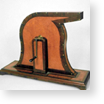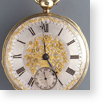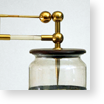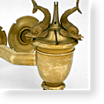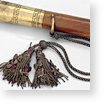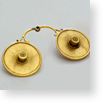In this room we can see how, starting in the 18th century, scientific instruments entered the homes of the upper classes. The vogue for experimental science created a new market for instrument makers who, along with one-of-a-kind pieces produced for collectors, introduced a series of standard instruments furnished with kits of accessories. In the large display case, containing an antique vetrine from Lorraine times, are compound microscopes, reflecting telescopes and electrostatic machines, which were used in the domestic sphere for cultural entertainment and self-learning. Some instruments - splendid table clocks, elegant globes, finely decorated barometers and thermometers - became furnishing items, displayed as symbols of cultural and social status. Extravagant objects such as telescopes for ladies equipped with ivory cosmetic boxes, and telescopes for gentlemen disguised as walking sticks, could also be found in upper-class homes.
Science in everyday life
Objects for daily use based on the laws of statics and dynamics. A specifically eighteenth-century device is the fan designed by John Theophilus Desaguliers, ...
(3 objects)
Watches from the Ruscitti Collection
In the early 15th century, clocks of smaller size started to be produced. They include wall clocks, table-clocks and watch. Through the 17th and 18th centuries ...
(25 objects)
Therapy and preventive care
Objects and devices for home medical care, from the traditional collection of small bottles of ointments and medicines to the most recent apparatuses for ...
(8 objects)
Science and interior decoration
Some scientific instruments became home furnishings, such as decorated wall-hanging barometers or globes for ornamental display. ...
(7 objects)
What’s the weather?
Reading instruments such as the barometer and thermometer to determine weather conditions became a routine occupation, thanks to the massive dissemination ...
(5 objects)
Recreational observations
In the home, science was also a recreational activity. Instruments such as the microscope and telescope could be used to instruct through entertainmen ...










